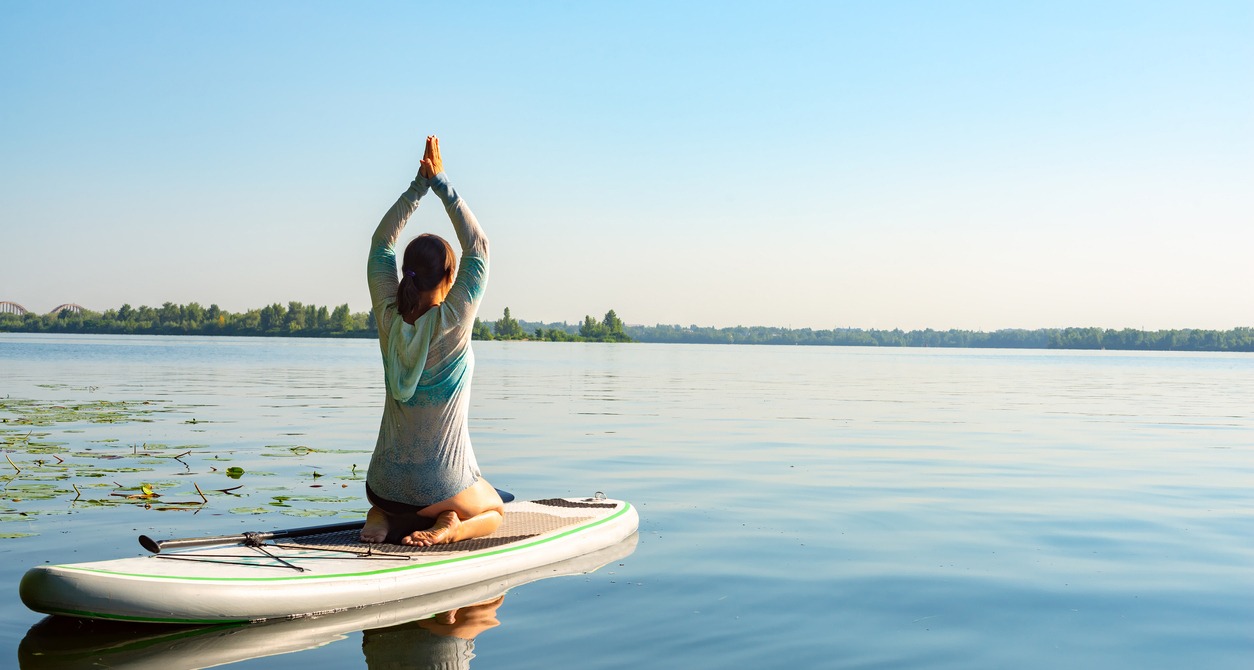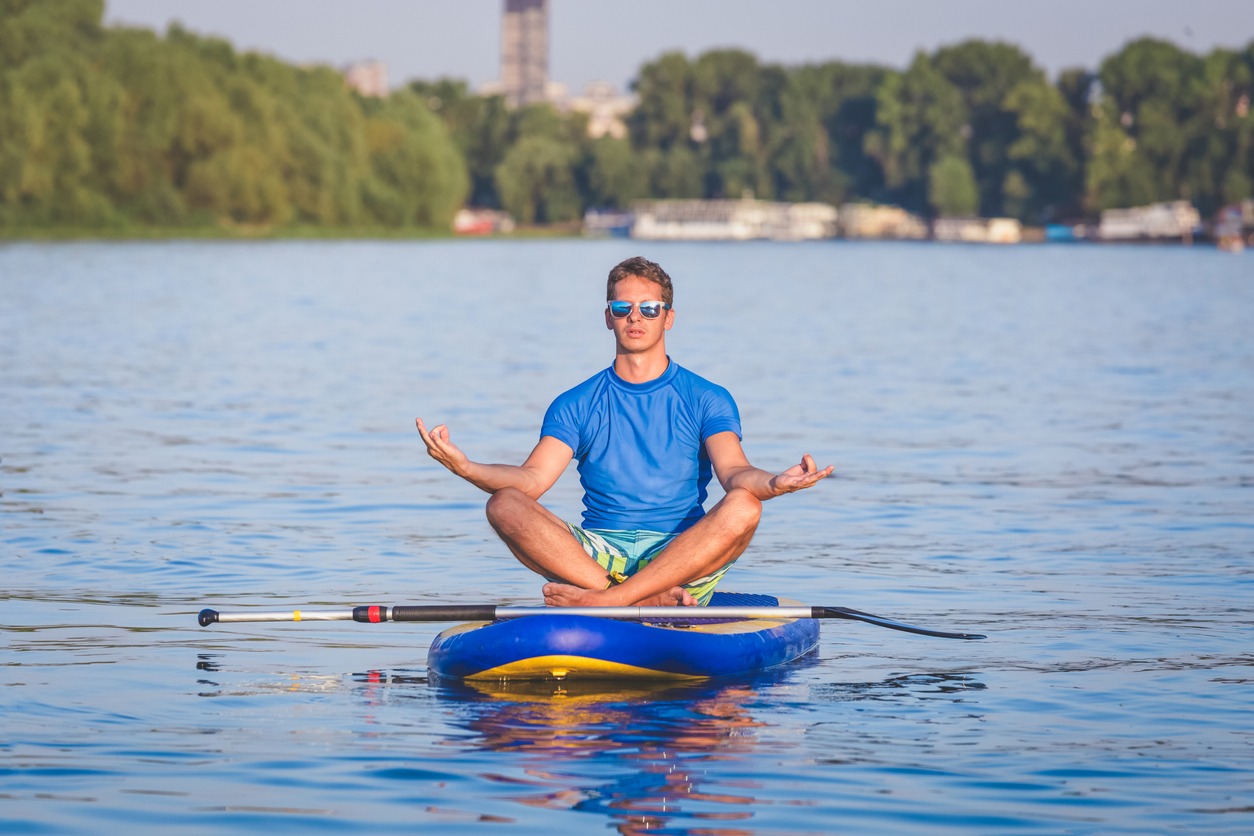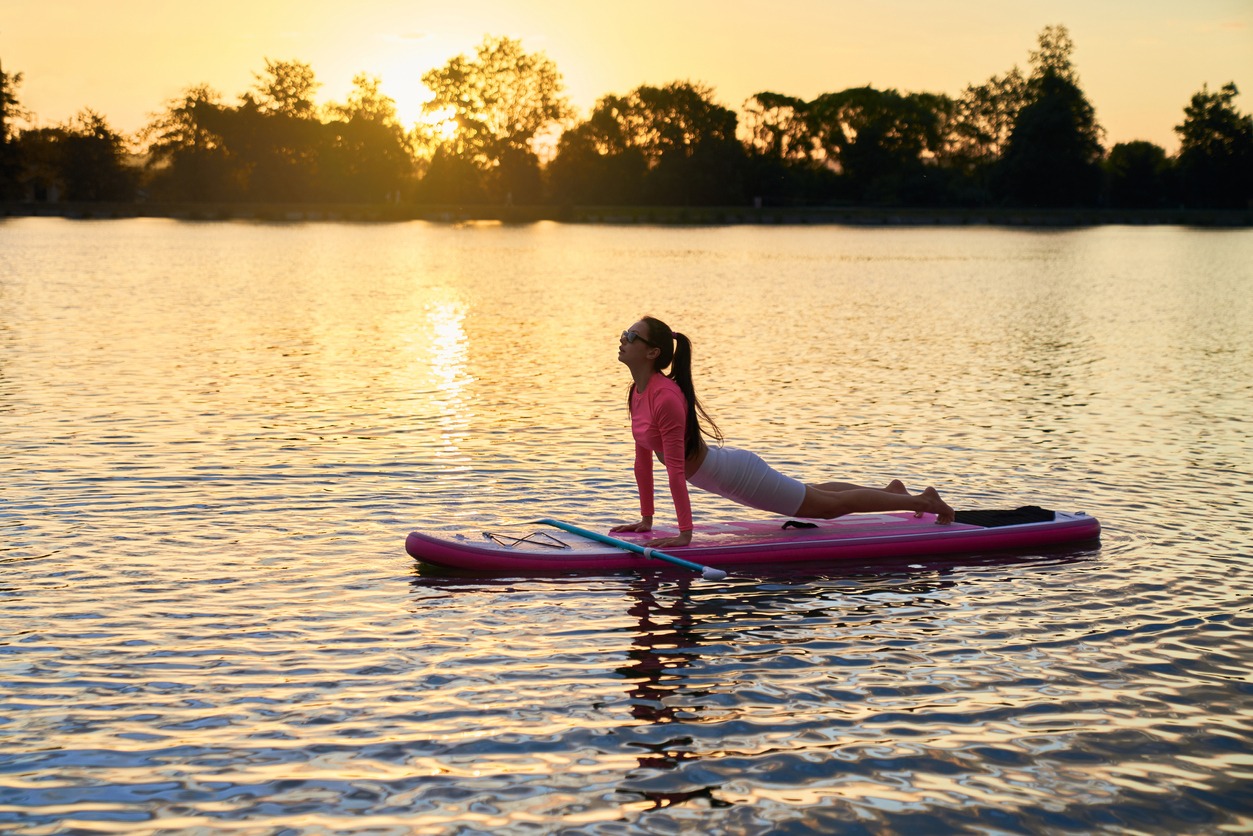Paddleboarding is a fun hobby that’s quite versatile as well. It’s a good exercise, a nice way to relax, and can be easily learned by beginners. An increasing number of people also use standup paddle boarding as a way to practice their yoga.
Standup paddleboard yoga can have a lot of benefits, but it’s not something that you can simply decide to try out one day. Like most other hobbies, this form of yoga requires a bit of preparation, equipment, and so on. If you’re planning to try out SUP yoga soon, here are some of the must-have gear that you might want to get before starting out.
Must-Have Paddleboard Yoga Gear
Having the right yoga gear can help you stay safe and focused on a paddleboard. Make sure to have the following essentials when you plan on doing this activity.
SUP Yoga Mat
Practicing yoga on a hard floor feels uncomfortable, and the same goes for practicing yoga on a paddleboard. Therefore, an SUP yoga mat is one of the most essential gear to avoid bruising your knees and ankles. A good quality mat can generally help in making the experience more soothing, which is the main goal of yoga.
SUP Yoga Board
A guide to buying stand-up paddle boards will help you choose the best board for your requirements. When choosing a paddleboard for yoga, it’s best to choose the one that you like most as long as it ticks all the necessary boxes. There are also options like inflatable standup paddleboards, which offer the same cushioning effect as a yoga mat. They also have the advantage of being lighter and more portable than regular paddle boards.
Aside from that, you also need a wider deck for increased stability and better balance while practicing SUP yoga. When buying your paddleboard, make sure to think about what you need it for and shortlist the options accordingly. It may also help to test out the board before launching it on water; stand up and try out several yoga poses on the deck there. If you can conduct them all without being cramped for space, that paddleboard model will be a likely option.
SUP boards for yoga can be from 33 to 40 inches wide. The common size for regular paddleboards is 10’6-inch long by 30-inch wide.
It may also help to have the following features in your SUP yoga board:
- Stable design with a flat-shaped deck
- Soft and cushy deck padding extending towards the tail and nose
Paddleboards, especially those designed for SUP yoga, can cost a fair bit. If you think it’s out of your budget or not worth the investment yet, consult any nearby shops or sporting goods stores for rental options.
Rope attachments
Some useful accessories for SUP yoga are anchor or rope attachments. You can use them to attach yourself or the board to a buoy, depending on where you will do your SUP yoga. You can also use these accessories to attach your paddle alongside your deck to prevent it from floating away. When you’re buying your essential stand-up paddleboarding accessories, make sure to keep the possibility of SUP yoga in mind.
An SUP paddle
There are also special SUP paddles in the market now; any model will be fine as long as it’s the proper size for your height. You can attach the paddle to the board using a rope while you’re practicing yoga poses. Alternatively, you can also just set it down near the board’s nose if the waters are stable enough.
A coil leash
This will allow you to tether yourself to the SUP. You can use it while paddling out into the water. Once you are in the right spot, you can anchor your board and take the leash off.
A PFD
A personal flotation device is usually a requirement when paddleboarding on any water body. State laws may vary, so check your region’s regulations before heading out. A compact and low-profile inflatable PFD is best, as it won’t interfere with the yoga routine.
Emergency whistle
This might be another requirement for paddleboarding anywhere. Most paddlers have their whistles attached to their personal flotation devices. This way, you can quickly and easily blow a warning or a request for help if necessary.
Anchor
This isn’t necessary for SUP, but may help to stabilize the board so that you can focus better–staying in one place is also necessary when you’re part of an SUP yoga class. A fishing anchor should be enough for stabilizing your board.
After you’ve let out the anchor and felt it hit the bottom, you should let out 3-4 more feet of the rope. Type the strand to your leash attachment, and pile up any excess rope on the tail of your paddleboard. An anchor is required in any region where the water depth is around 10 to 15 feet or more.
The Difference between SUP Yoga and Land Yoga
You might be wondering: why would anyone want to practice yoga on a paddleboard? After all, the ground is a much more stable platform. A gym, your own home, or anywhere onshore will probably be the more comfortable and convenient choice for a balancing exercise such as yoga.
However, SUP yoga is not just about challenging yourself or looking good for pictures. To better understand why people go for this type of yoga, let’s have a look at the differences between regular and SUP yoga:
1. The balance factor
Stand-up paddleboard yoga or SUP yoga requires more balance compared to land-based yoga practice. When we try to balance, our micro muscles become engaged to support the big muscles.
Therefore, if you are balancing on the water, these micro muscles will always be active. It is a kind of invisible workout, which is pretty impressive. Think of it like working out with weights versus without. Even the addition of a little dumbbell can help us achieve faster, more toned results in our body.
2. Requires extra focus
Another difference is the extra focus required for the constant state of balance. It’s because even just standing still on a stand-up paddleboard without doing any poses yet means telling your body to adjust. This means that being on a paddleboard is helping you to clear your mind by forcing you to become present with the task at hand. Here, the main focus at first will be to stay dry, stay on the board, and stay as stable as possible.
3. Boosting endorphins
Lastly, doing mindful practice in nature can boost endorphins. Doing yoga in a studio can create a calm and peaceful environment, but it will not match up to the serenity you can get from floating around on the water.
4. Challenging yourself
If you’ve been practicing yoga on land for some time, the routine might have gotten a bit monotonous. By trying out a challenge like SUP yoga, even the simplest yoga pose will present a little more challenge. This could motivate you further and even push your body out of a health or weight plateau. In a way, you’ll be a curious beginner again and be able to engage better with these new challenges to your body.
Tips for Beginners in SUP Yoga
If you’re considering SUP yoga for the first time, the following tips may help in making your experience comfortable and effective:
- Find a spot that’s not too windy and doesn’t have big waves; the more stable you are, the more focused you can be on yoga practice
- If you’re not attending a class or just don’t like a lot of people observing you, get away from crowded areas
- Move slower than usual when trying out your yoga poses
- Go for a wide stance in order to have a stable base
- Avoid poses with just one point of contact; in SUP yoga, you should have two points of contact with your paddleboard at all times
- For more stability choose poses that align your body perpendicular to your paddleboard (warrior I and II are good examples of these)
- Be mentally prepared to be a little less in control; the board will be drifting a little and even a little wave might knock you off balance
Different Paddleboard Yoga Poses for Beginners
If you can breathe in and out while standing on one leg without falling, then you can definitely learn paddleboard yoga easily. If you’re interested in trying SUP yoga out, we are going to help you get started.
Just like land-based yoga, there are many different poses you can do on a paddleboard. For beginners, here are some of the best poses to try out:
1. Downward-Facing Dog
This pose can help you stretch out the spine, shoulders, and legs. It is a very easy pose to balance on a SUP because you keep four points of contact on the board. From a table position, lift the hips, sending the tailbone back and up to the sky. Then, melt the shoulders down so they will be in line with your head. This pose is also a great core and arm-strengthening exercise.
2. Upward-Facing Dog
This is the reverse pose of the downward-facing dog. Lie down and place your hands next to your ribs. Then push up and raise your torso. Since your quads will be engaged, your knees might lift off the ground as well.
3. Easy-Seated Pose
To do this pose, simply cross your legs, and straighten your back. Gently rest your hand on your knees as you take deep breaths.
4. One-Legged King Pigeon
This is a nourishing pose and a “hip opener” as well. It is ideal for a comfortable balance because it is a low to the ground pose. From the table position, bring one leg forward to rest the knee between your hands. Then, extend the other leg back. After that, take a seated position and push your chest forward.
5. Bridge Pose
To do the bridge pose, lie down on your back, keep your feet grounded, then bend your knees as you raise your hips. Make sure to keep your shoulders and arms on the ground.
6. Child’s Pose
To do the child’s pose, from a tabletop pose, move your feet to touch each other, and then bring your hips back to rest on your heels. Leave your hands stretched out in front of you.
7. Plank
This is a popular yoga position that you can easily try out while doing SUP yoga. From the downward-facing dog pose, move your body forward to form a straight line from your head to your heels. Then, keep your arms vertical under your shoulders.
8. Low Lunge
To do the low lunge pose, from the tabletop position, bring one foot forward slowly in between your hands. Then rest your hands on your knee or thigh. Or you can also raise them in the air. Alternate doing this pose with each foot.
9. Chair Pose
This one is a bit challenging. Stand tall with your arms raised on the paddle board. Then, lower your hips into a seated position. You can also hold your paddle in the air while balancing.
10. Savasana
This is the last part of your SUP yoga. You simply lie on your back and make your body feel relaxed. Breathe a happy sigh of relief because you just finished your SUP yoga.
Conclusion
Are you someone who loves yoga and stand up paddle boarding at the same time? If you are, then stand up paddleboard (SUP) yoga might be perfect for you. It’s because it combines yoga and paddleboarding in one fun activity. It is a fun way to exercise while relaxing and calming the mind.
When you think about it, yoga is also one of the best hobbies you can take with you when traveling.
Paddleboard yoga is a unique kind of exercise with the combined benefits of yoga and an added element of fun. Of course, it’s best if you have already experience in either regular yoga or regular SUP (or both). However, if you want to try out SUP yoga directly, there’s no harm if you take proper safety precautions. It might be safest to try out an SUP yoga class first, or practice in shallow waters or near a lifeguard.



